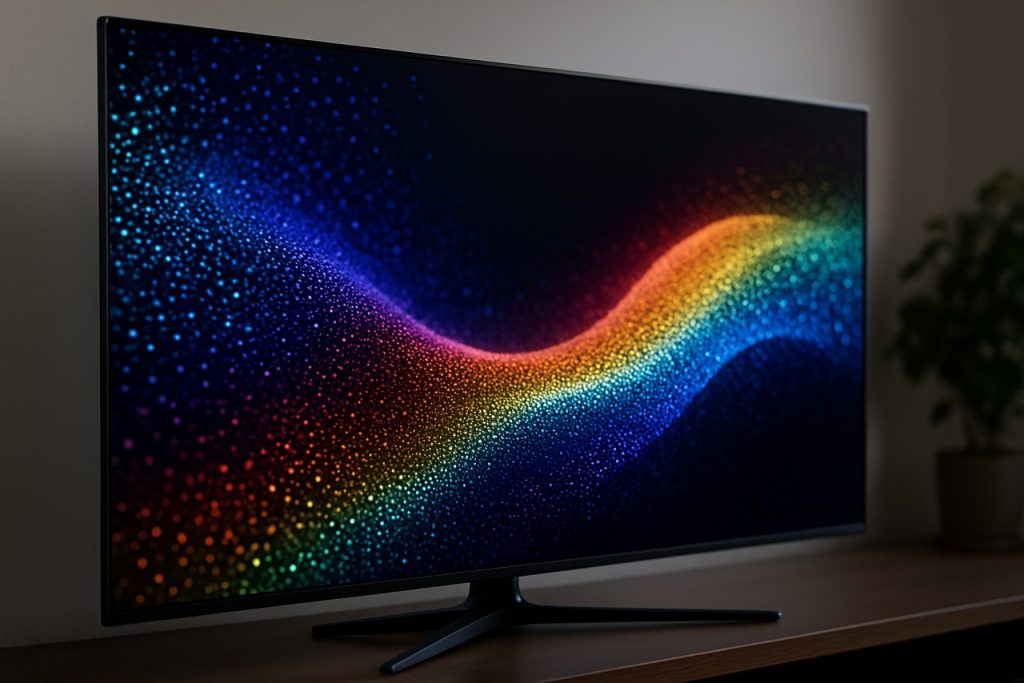
Quantum Dot Display Technology Market Report 2025: In-Depth Analysis of Growth Drivers, Competitive Dynamics, and Future Opportunities. Explore Key Trends, Regional Insights, and Forecasts Shaping the Industry.
- Executive Summary & Market Overview
- Key Technology Trends in Quantum Dot Displays
- Competitive Landscape and Leading Players
- Market Growth Forecasts (2025–2030): CAGR, Revenue, and Volume Analysis
- Regional Market Analysis: North America, Europe, Asia-Pacific, and Rest of World
- Future Outlook: Innovations and Emerging Applications
- Challenges, Risks, and Strategic Opportunities
- Sources & References
Executive Summary & Market Overview
Quantum dot display technology represents a transformative advancement in the display industry, leveraging nanocrystal semiconductors—known as quantum dots—to deliver superior color accuracy, brightness, and energy efficiency compared to traditional LCD and OLED displays. As of 2025, the global quantum dot display market is experiencing robust growth, driven by increasing demand for high-performance displays in consumer electronics, particularly televisions, monitors, and mobile devices.
According to MarketsandMarkets, the quantum dot display market is projected to reach USD 10.6 billion by 2025, growing at a CAGR of over 23% from 2020. This growth is fueled by the technology’s ability to provide a wider color gamut and enhanced visual experiences, which are highly valued in premium product segments. Major electronics manufacturers such as Samsung Electronics and LG Electronics have integrated quantum dot technology into their flagship TV lines, further accelerating market adoption.
Regionally, Asia-Pacific dominates the quantum dot display market, accounting for the largest share due to the presence of leading display panel manufacturers and a strong consumer electronics industry. North America and Europe are also significant markets, driven by early adoption of advanced display technologies and high consumer purchasing power.
Key trends shaping the market in 2025 include:
- Continued innovation in quantum dot materials, with a shift towards cadmium-free solutions to address environmental and regulatory concerns.
- Expansion of quantum dot applications beyond TVs and monitors, including tablets, smartphones, automotive displays, and medical imaging devices.
- Strategic partnerships and investments by major players such as Nanosys and Nanoco Group to scale production and enhance material performance.
Despite the promising outlook, the market faces challenges such as high production costs and competition from emerging display technologies like microLED. However, ongoing R&D and economies of scale are expected to drive down costs and further solidify quantum dot displays as a leading technology in the display sector.
Key Technology Trends in Quantum Dot Displays
Quantum dot display technology is at the forefront of next-generation display innovation, leveraging nanometer-scale semiconductor particles—quantum dots (QDs)—to deliver superior color accuracy, brightness, and energy efficiency compared to traditional LCD and OLED panels. As of 2025, several key technology trends are shaping the evolution and adoption of quantum dot displays across consumer electronics, automotive, and commercial applications.
- QD-OLED and QD-LED Integration: The convergence of quantum dots with organic light-emitting diode (OLED) technology, resulting in QD-OLED displays, is gaining momentum. This hybrid approach combines the deep blacks and contrast of OLED with the enhanced color gamut and brightness of quantum dots. Major manufacturers such as Samsung Display and Sony are commercializing QD-OLED panels, targeting premium TV and monitor segments.
- Cadmium-Free Quantum Dots: Environmental and regulatory pressures are accelerating the shift toward cadmium-free quantum dots, such as indium phosphide (InP) and perovskite-based materials. These alternatives offer comparable performance while meeting global environmental standards, as highlighted by Nanoco Group and Nanosys.
- Quantum Dot Color Conversion (QDCC): QDCC technology is enabling more efficient and precise color conversion in displays, particularly for microLED and OLED architectures. This trend is critical for achieving ultra-high resolution and color purity in next-generation displays, as reported by Display Daily.
- Flexible and Transparent QD Displays: Advances in quantum dot ink formulations and printing techniques are paving the way for flexible and transparent displays. These innovations are expanding the application scope of QD displays to automotive dashboards, wearable devices, and augmented reality (AR) systems, according to IDTechEx.
- Manufacturing Scalability and Cost Reduction: Continuous improvements in quantum dot synthesis, encapsulation, and integration processes are driving down production costs and enabling mass-market adoption. Companies like TCL and LG Electronics are scaling up QD display manufacturing for mainstream consumer products.
These technology trends are collectively propelling quantum dot displays toward broader commercialization and setting new benchmarks for visual performance in the display industry.
Competitive Landscape and Leading Players
The competitive landscape of the quantum dot display technology market in 2025 is characterized by intense rivalry among established electronics giants, innovative startups, and material science specialists. The sector is primarily driven by the demand for high-performance displays in televisions, monitors, smartphones, and automotive applications. Key players are leveraging proprietary quantum dot formulations, strategic partnerships, and vertical integration to secure market share and technological leadership.
Samsung Electronics remains the dominant force, capitalizing on its early investments in quantum dot-enhanced LCDs (QLED TVs) and its robust global distribution network. The company’s continued R&D in cadmium-free quantum dots and hybrid QD-OLED panels has reinforced its leadership, with new product launches in 2025 targeting both premium and mid-range segments. LG Electronics is also a significant contender, focusing on integrating quantum dot technology with its OLED offerings to enhance color accuracy and brightness, positioning itself as a premium alternative.
Chinese manufacturers such as TCL Technology and Hisense are rapidly expanding their quantum dot display portfolios, leveraging cost efficiencies and aggressive pricing strategies. TCL, in particular, has made notable advances in inkjet-printed quantum dot displays, aiming to reduce production costs and scale up manufacturing. These companies are increasingly targeting international markets, intensifying competition with established brands.
On the materials front, Nanosys, Inc. continues to be a pivotal supplier of quantum dot materials, collaborating with display manufacturers worldwide. The company’s innovations in heavy-metal-free quantum dots and improved quantum efficiency have been widely adopted across the industry. Other material innovators, such as Nanoco Group and QD Laser, are also gaining traction, particularly in niche applications and environmentally compliant solutions.
Strategic alliances and licensing agreements are shaping the competitive dynamics, with display panel makers partnering with quantum dot material suppliers to accelerate commercialization and differentiation. The market is also witnessing increased investment in next-generation technologies, such as quantum dot micro-LEDs and electroluminescent quantum dot displays, which promise further performance gains and new application areas.
Overall, the 2025 quantum dot display technology market is marked by rapid innovation, global expansion, and a race to deliver superior visual experiences, with leading players continuously adapting to evolving consumer preferences and regulatory requirements.
Market Growth Forecasts (2025–2030): CAGR, Revenue, and Volume Analysis
The quantum dot display technology market is poised for robust growth in 2025, driven by increasing adoption in consumer electronics, particularly televisions, monitors, and mobile devices. According to projections by MarketsandMarkets, the global quantum dot market is expected to reach a value of approximately USD 8.6 billion by 2025, with display applications accounting for a significant share of this revenue. The compound annual growth rate (CAGR) for quantum dot display technology is forecasted to be around 23% from 2025 to 2030, reflecting strong momentum as manufacturers continue to integrate quantum dots for enhanced color performance and energy efficiency.
Volume analysis indicates that the number of quantum dot-enabled display panels shipped worldwide will see a substantial increase in 2025. Statista estimates that shipments could surpass 30 million units in 2025, up from approximately 20 million units in 2023. This surge is attributed to the growing consumer preference for premium displays with superior color accuracy and brightness, as well as the expansion of quantum dot technology into mid-range product segments.
Revenue growth is further supported by strategic partnerships and investments from leading display manufacturers such as Samsung Electronics and LG Electronics, both of which are scaling up production capacities and introducing new product lines featuring quantum dot enhancements. Additionally, the entry of Chinese panel makers like BOE Technology Group and China Star Optoelectronics Technology (CSOT) is intensifying competition and driving down costs, making quantum dot displays more accessible to a broader consumer base.
- CAGR (2025–2030): ~23%
- Projected Market Revenue (2025): USD 8.6 billion
- Estimated Display Panel Shipments (2025): 30+ million units
In summary, 2025 marks a pivotal year for quantum dot display technology, with strong revenue and volume growth forecasts underpinned by technological advancements, competitive pricing, and expanding applications across the consumer electronics landscape.
Regional Market Analysis: North America, Europe, Asia-Pacific, and Rest of World
The regional market analysis for quantum dot display technology in 2025 reveals distinct growth trajectories and adoption patterns across North America, Europe, Asia-Pacific, and the Rest of the World. Each region’s market dynamics are shaped by factors such as consumer electronics demand, manufacturing capabilities, R&D investments, and regulatory environments.
- North America: The North American market, led by the United States, continues to demonstrate robust growth in quantum dot display adoption, driven by high consumer demand for premium televisions, monitors, and mobile devices. Major technology companies and display manufacturers, such as Samsung Electronics and Apple Inc., have established partnerships and R&D centers in the region, fostering innovation. The presence of leading research institutions and a strong focus on next-generation display technologies further bolster market expansion. According to Grand View Research, North America is expected to maintain a significant market share through 2025, supported by early adoption trends and high disposable incomes.
- Europe: Europe’s quantum dot display market is characterized by a growing emphasis on energy efficiency and environmental sustainability. Regulatory frameworks, such as the EU’s RoHS directive, encourage the adoption of cadmium-free quantum dot solutions. Leading European electronics brands, including Philips and Vestel, are increasingly integrating quantum dot technology into their product lines. The region’s market growth is also supported by government-funded research initiatives and collaborations with global technology providers, as highlighted by MarketsandMarkets.
- Asia-Pacific: Asia-Pacific remains the largest and fastest-growing market for quantum dot displays, accounting for the majority of global production and consumption. Countries such as China, South Korea, and Japan are home to leading display panel manufacturers, including LG Display, Samsung Display, and BOE Technology Group. The region benefits from a well-established electronics manufacturing ecosystem, strong government support, and rising consumer demand for high-end displays. According to IDC, Asia-Pacific’s dominance is expected to persist through 2025, with continued investments in R&D and capacity expansion.
- Rest of World: In regions outside the major markets, adoption of quantum dot display technology is at an earlier stage but shows promising potential. Latin America and the Middle East & Africa are witnessing gradual uptake, primarily driven by the import of finished products and increasing consumer awareness. Market growth in these regions is expected to accelerate as local economies develop and access to advanced display technologies improves, as noted by Fortune Business Insights.
Future Outlook: Innovations and Emerging Applications
Looking ahead to 2025, quantum dot display technology is poised for significant advancements, driven by both material innovations and the expansion of emerging applications. Quantum dots (QDs), semiconductor nanocrystals that emit precise wavelengths of light, have already transformed the color performance and energy efficiency of displays. The next wave of innovation is expected to focus on the development of cadmium-free quantum dots, such as indium phosphide (InP) and perovskite-based materials, to address environmental and regulatory concerns while maintaining or surpassing the color gamut and brightness of traditional cadmium-based QDs. Companies like Nanosys and Samsung Electronics are at the forefront of this transition, with ongoing research into more stable and efficient QD materials.
Emerging applications are set to broaden the impact of quantum dot technology beyond premium televisions and monitors. In 2025, QDs are expected to play a pivotal role in the development of next-generation displays, including flexible and transparent screens for automotive, wearable, and augmented reality (AR) devices. The integration of QDs with OLED (QLED and QD-OLED) and microLED architectures is anticipated to deliver displays with unprecedented color accuracy, higher peak brightness, and improved energy efficiency, as highlighted in recent reports by IDC and Display Daily.
- Flexible and Foldable Displays: Quantum dots’ compatibility with solution-based processing enables their use in flexible substrates, paving the way for rollable and foldable screens in consumer electronics.
- Automotive and Industrial Applications: Enhanced durability and brightness make QD displays suitable for automotive dashboards and industrial control panels, where visibility and reliability are critical.
- Medical Imaging and Diagnostics: The precise color rendering and tunable emission properties of QDs are being explored for advanced medical imaging devices and diagnostic tools, as noted by MarketsandMarkets.
Furthermore, sustainability will be a key focus, with manufacturers investing in eco-friendly production processes and recyclable QD materials. As intellectual property portfolios expand and manufacturing costs decline, the adoption of quantum dot displays is projected to accelerate across diverse sectors, positioning the technology as a cornerstone of the display industry’s future.
Challenges, Risks, and Strategic Opportunities
Quantum dot display technology, while offering significant advancements in color accuracy, energy efficiency, and brightness, faces a complex landscape of challenges, risks, and strategic opportunities as it moves into 2025. One of the primary challenges is the high cost of production, particularly for cadmium-free quantum dots, which are increasingly demanded due to environmental regulations. The transition to environmentally friendly materials, such as indium phosphide, has increased R&D and manufacturing expenses, impacting the price competitiveness of quantum dot displays compared to OLED and emerging microLED technologies (IDTechEx).
Another significant risk is the rapid pace of innovation in adjacent display technologies. OLED and microLED displays continue to improve in terms of performance and cost, posing a threat to the market share of quantum dot displays. Additionally, intellectual property (IP) disputes and patent expirations could disrupt supply chains and market dynamics, as key patents held by early innovators begin to expire, potentially leading to increased competition and commoditization (MarketsandMarkets).
Supply chain vulnerabilities also present risks, particularly in sourcing high-purity raw materials and ensuring consistent quality at scale. Geopolitical tensions and export restrictions on critical materials, such as indium, could further exacerbate these risks, leading to price volatility and potential shortages (Grand View Research).
Despite these challenges, strategic opportunities abound. The growing demand for high dynamic range (HDR) and wide color gamut displays in premium televisions, monitors, and mobile devices positions quantum dot technology as a key differentiator for manufacturers targeting the high-end market segment. Furthermore, the integration of quantum dots with emerging display architectures, such as QD-OLED and QNED, offers pathways to enhanced performance and new product categories (Display Daily).
Strategic partnerships between quantum dot material suppliers and major display panel manufacturers are also accelerating commercialization and driving down costs through economies of scale. Companies investing in next-generation, cadmium-free quantum dot materials and scalable manufacturing processes are well-positioned to capture market share as regulatory pressures and consumer preferences shift toward sustainable technologies (Statista).
Sources & References
- MarketsandMarkets
- LG Electronics
- Samsung Display
- Display Daily
- IDTechEx
- Hisense
- QD Laser
- Statista
- Apple Inc.
- Grand View Research
- Philips
- Vestel
- IDC
- Fortune Business Insights



